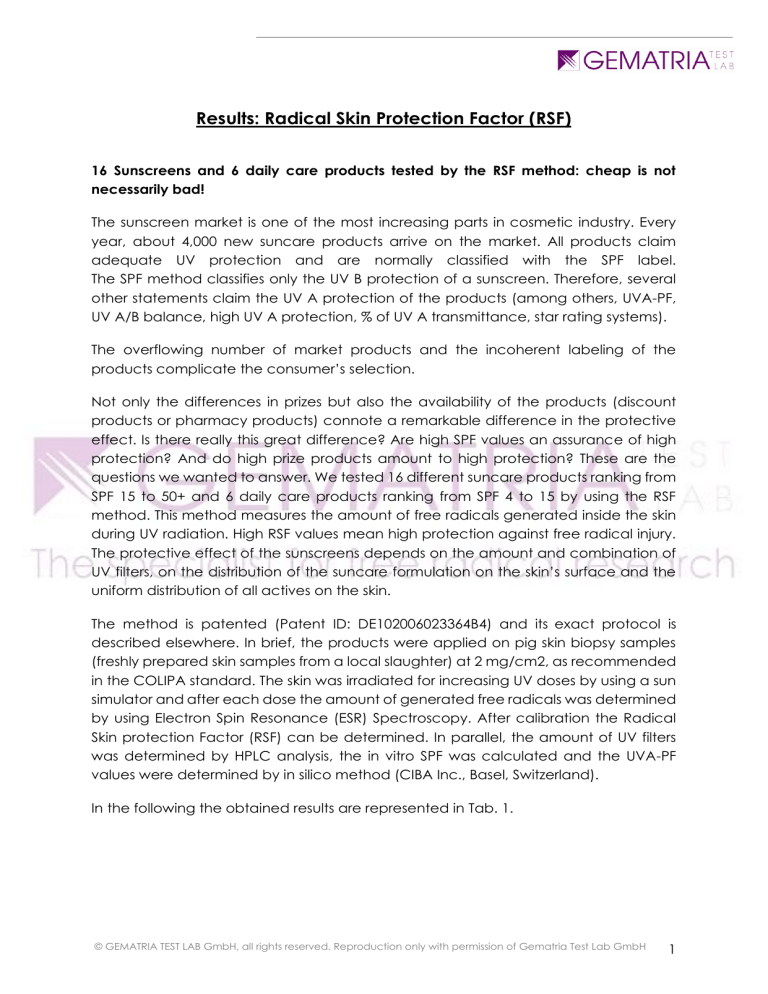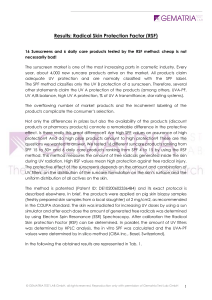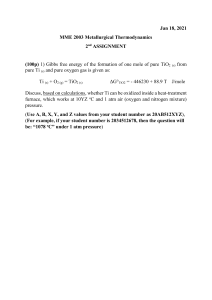
Results: Radical Skin Protection Factor (RSF) 16 Sunscreens and 6 daily care products tested by the RSF method: cheap is not necessarily bad! The sunscreen market is one of the most increasing parts in cosmetic industry. Every year, about 4,000 new suncare products arrive on the market. All products claim adequate UV protection and are normally classified with the SPF label. The SPF method classifies only the UV B protection of a sunscreen. Therefore, several other statements claim the UV A protection of the products (among others, UVA-PF, UV A/B balance, high UV A protection, % of UV A transmittance, star rating systems). The overflowing number of market products and the incoherent labeling of the products complicate the consumer’s selection. Not only the differences in prizes but also the availability of the products (discount products or pharmacy products) connote a remarkable difference in the protective effect. Is there really this great difference? Are high SPF values an assurance of high protection? And do high prize products amount to high protection? These are the questions we wanted to answer. We tested 16 different suncare products ranking from SPF 15 to 50+ and 6 daily care products ranking from SPF 4 to 15 by using the RSF method. This method measures the amount of free radicals generated inside the skin during UV radiation. High RSF values mean high protection against free radical injury. The protective effect of the sunscreens depends on the amount and combination of UV filters, on the distribution of the suncare formulation on the skin’s surface and the uniform distribution of all actives on the skin. The method is patented (Patent ID: DE102006023364B4) and its exact protocol is described elsewhere. In brief, the products were applied on pig skin biopsy samples (freshly prepared skin samples from a local slaughter) at 2 mg/cm2, as recommended in the COLIPA standard. The skin was irradiated for increasing UV doses by using a sun simulator and after each dose the amount of generated free radicals was determined by using Electron Spin Resonance (ESR) Spectroscopy. After calibration the Radical Skin protection Factor (RSF) can be determined. In parallel, the amount of UV filters was determined by HPLC analysis, the in vitro SPF was calculated and the UVA-PF values were determined by in silico method (CIBA Inc., Basel, Switzerland). In the following the obtained results are represented in Tab. 1. © GEMATRIA TEST LAB GmbH, all rights reserved. Reproduction only with permission of Gematria Test Lab GmbH 1 Table 1: Studied sunscreens (1-16, yellow) and daily care products (17-22, green) N# UV Filter Amount UV B………...…………UV A (%) Label 01 OC 15 02 DTM OC 03 TiO2 TiO2 04 05 PBSA DTB EHT TiO2 OC 5,5 4,8 1,5 8,1 3,0 2,2 4,2 4,6 3,0 2,1 2,0 1,6 5,2 9,1 2,5 2,3 1,5 0,5 5,0 2,8 2,5 2,3 2,0 1,0 0,5 0,5 6,3 2,5 10,0 2,0 2,0 0,1 0,1 10,0 4,0 10,0 7,4 7,0 5,9 0,7 10,0 5,2 2,8 1,5 9,1 5,2 1,4 0,5 TiO2 06 EHT DTS 07 TiO2 08 EHMC TiO2 09 EHMC 10 EHMC TiO2 OC TiO2 12 BMDBM BEMT OC BMDBM BMDBM DTS EHS TiO2 OC 11 BMDBM TDSA BMDBM BEMT TDSA BEMT BEMT MBBT ZnO MBBT MBBT DHHB ZnO BMDBM BEMT MBBT BEMT BMDBM SPF UVA-PF RSF 15,8 8,3 10,6 20 18,6 10,2 16,5 55 45,7 10,0 6,8 20 20 6,3 23,2 2,4 10,9 2,4 11,3 40 27,7 12,1 16,5 25 20,3 7,8 13,0 20 28,5 6,8 13,0 25 28,5 5,8 6,3 55 63,1 28,2 23,1 30 30 16,4 10,6 20 21,2 16,3 18,2 Calc © GEMATRIA TEST LAB GmbH, all rights reserved. Reproduction only with permission of Gematria Test Lab GmbH 2 13 OC BMDBM TiO2 14 BEMT EHT OC TiO2 DTS 15 16 17 OCR EHMC 18 EHMC PBSA TiO2 EHMC 19 PBSA TiO2 OCR 20 OCR 21 22 DTS OCR EHT TiO2 PABA BMDBM TDSA DHHB BMDBM BMDBM BMDBM TDSA EHMC BMDBM BMDBM MBBT 8,0 2,0 2,0 1,0 0,3 9,1 2,9 2,5 0,5 0,5 5,5 10,0 7,8 1,4 8,0 1,8 0,8 7,2 2,1 1,5 0,3 1,6 0,3 5,0 3,1 2,1 1,5 5,0 1,0 4,1 3,1 1,5 0,3 0,3 25 21,1 9,9 27,1 20 23,8 11,2 18,2 20 20 8 23 1,1 3,9 2,1 4,1 15 13 1,5 3,6 15 17 3,6 5,1 4 3 2,1 3,9 15 15 12,3 11,8 8 8 2,5 7,5 15 18 5,0 8,0 Table 2: Abbreviation list of the UV filters used in the study Abbrev. INCI BEMT BMDBM DBT DHHB DTS EHMC EHS EHT MBBT OC PABA PBSA TDSA TiO2 ZnO Bis-Ethylhexyloxyphenol Methoxyphenol Methoxyphenyl Triazine Butyl Methoxydibenzoylmethane Dietyhlhexyl Butamido Triazone Diethylamino Hydroxybenzoyl Hexyl Benzoat Drometrizole trisiloxane Ethylhexyl Methoxycinnamate Ethylhexyl salicilate Ethylhexyl Triazone Methylene Bis-Benzotriazolyl Tetramethylbutylphenol Octocrylene para-aminobenzoic acid Phenyl benzimidazole Sulfonic Acid Terephthalylidene Dicamphor Sulfonic Acid Titanium Dioxide Zinc Oxide Use (x) 7 14 1 2 4 6 2 4 5 11 1 2 4 13 2 © GEMATRIA TEST LAB GmbH, all rights reserved. Reproduction only with permission of Gematria Test Lab GmbH 3 The aim of this study was to investigate whether the reduction of free radical generation is a measure for protection against UVA radiation. Besides the RSF value, the UVA-PF was determined in vitro and SPF and UVA-PF were also assessed in silico by the sunscreen simulator computer program. There is a correlation UVA-PF = 0.33 SPF over all samples confirming that half of them comply with the EC UVA recommendation. Among the half that complies the correlation UVA-PF = 0.50 SPF was found. The RSF is similarly correlated with the SPF; RSF = 0.4 SPF over all samples and RSF = 0.55 SPF for EC-UVA compliant half of the samples, but the variance is much higher leading to a correlation coefficient close to zero. The RSF was found to be correlated to the UVA-PF, RSF = (1.0 - 1.3) UVA-PF, depending on the SPF range of the samples. The deviation from the perfect correlation can be explained by the various influence factors on both methods. In particular, the interaction of the sunscreen formulation with the skin’s surface determines the greatest deviation from the in vitro results. The formation of a uniform film layer, the hydration of the skin, the penetration ability of the filters inside the skin are, among others, the main factors that influence the protection effect of a cosmetic formulation. In conclusion the RSF is able to provide the information on UVA protection which is required in addition to the SPF. Furthermore in vitro assessments of UVA protection can also serve as a valuable estimation of the RSF. © GEMATRIA TEST LAB GmbH, all rights reserved. Reproduction only with permission of Gematria Test Lab GmbH 4





